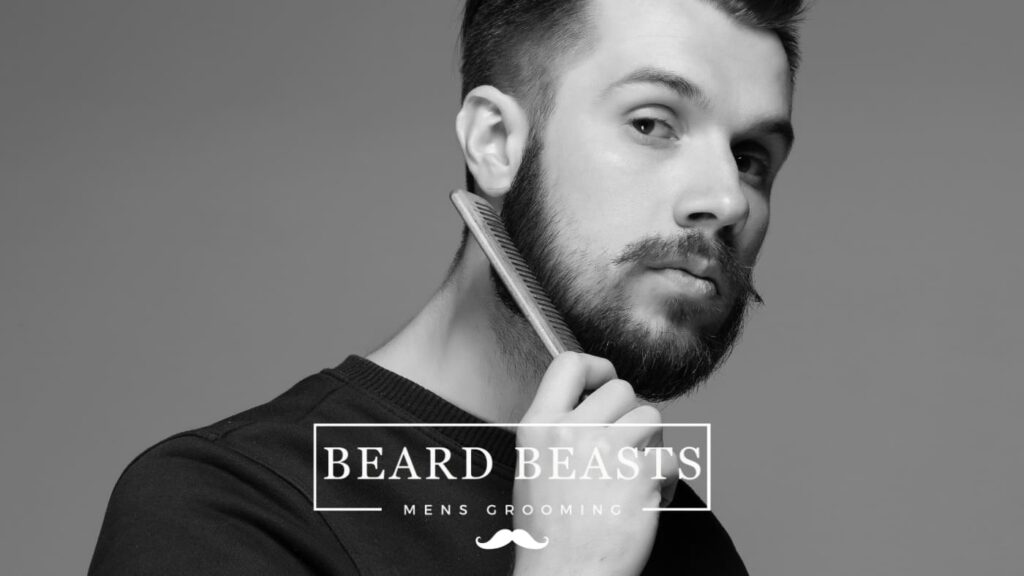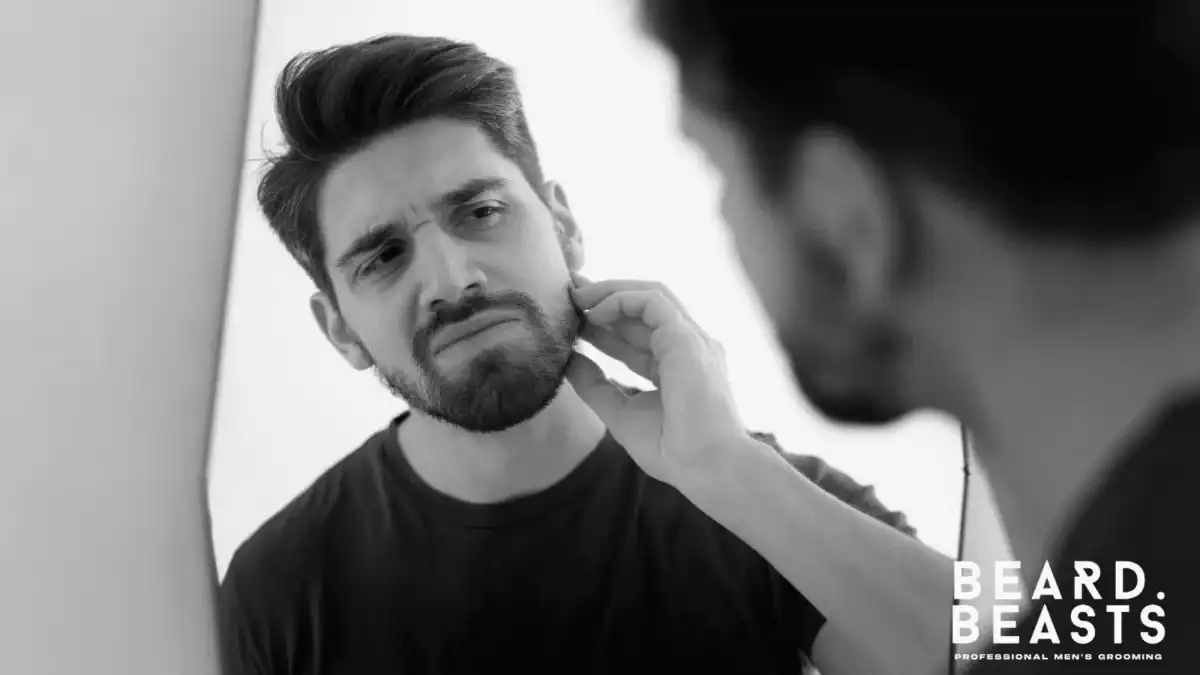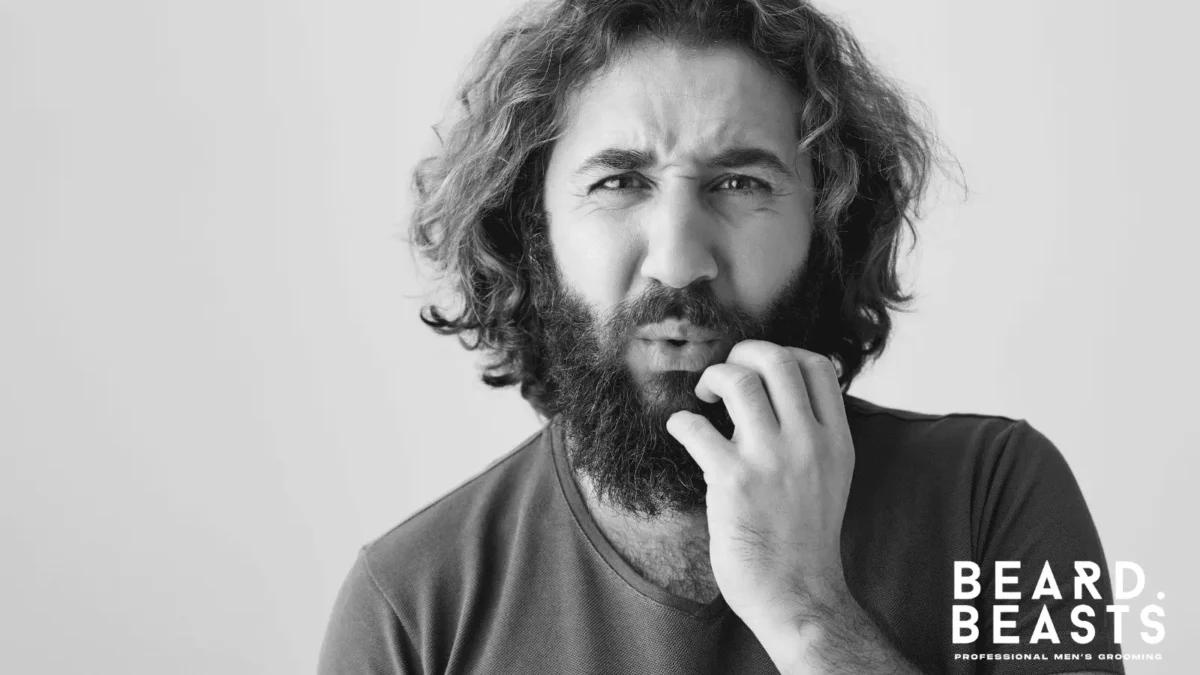Welcome to the comprehensive guide on navigating the world of thin beards. Whether you’re experiencing beard thinning or naturally have a thin beard, this article is designed to provide you with essential insights and practical tips to enhance your beard’s appearance.
From understanding the factors that contribute to a thin beard to discovering the best styles for thin beards and debunking common myths, we’ll cover everything you need to know to make the most of your facial hair.
Our goal is to help you embrace your unique beard, offering advice on grooming, maintenance, and styling to ensure your beard looks its best.
Get ready to transform the way you see and care for your thin beard, armed with knowledge and confidence.

Understanding Your Thin Beard
When it comes to nurturing a beard, many find themselves grappling with a thin or patchy appearance. If you’re aiming to achieve a fuller look, it’s crucial to delve into the root causes behind a thin beard.
Genetics and Thin Beards
The foundation of your beard’s density and growth pattern is largely written in your DNA. If your ancestors sported lush beards, chances are higher you might too. However, genetics can also be the reason behind a thinner beard, dictating how each hair follicle responds to hormonal signals. It’s essential to recognize that, despite genetic predispositions, there are ways to enhance your beard’s appearance.
Health and Lifestyle Factors
Your daily habits play a significant role in the health and thickness of your beard. A diet rich in vitamins and minerals, such as vitamins A, B, C, E, and zinc, can foster healthier beard growth. Regular exercise boosts overall health and increases blood circulation, which aids in nutrient delivery to your hair follicles. Don’t underestimate the power of good sleep; it’s when your body repairs itself, impacting beard health directly.
Hormonal Influences
The hormones testosterone and dihydrotestosterone (DHT) are key players in facial hair development. Low levels of these hormones can result in beard thinning or slow growth. Testosterone is converted to DHT, which then interacts with hair follicles to promote beard growth. Enhancing your lifestyle to support hormonal balance—such as reducing stress, getting adequate sleep, and maintaining a balanced diet—can indirectly contribute to a fuller beard.
In summary, while genetics set the stage for your beard’s potential, health and lifestyle factors, along with hormonal balances, are the actors that determine its growth and fullness. Embracing the best styles for thin beards, understanding beard thinning, and adopting a healthy lifestyle can make a significant difference in your beard’s appearance. Remember, each facial hair is unique; celebrating and working with what you have can lead to impressive results and a style that suits you best.
Essential Tips for Growing a Thicker Beard
Achieving a thicker beard is a common goal for many, but it often requires a bit of effort and dedication. If you’re looking to transform your thin beard into a fuller, more robust facial feature, here are some essential tips that can guide you on your journey.
Optimizing Your Diet
The saying “you are what you eat” rings true when it comes to beard growth. For a healthier, thicker beard, your diet should be rich in specific nutrients and vitamins. Focus on foods high in proteins, such as chicken, fish, eggs, and legumes, as these are the building blocks of hair. Vitamins A, B, C, and E, along with minerals like zinc and iron, play critical roles in hair growth and repair. Incorporating a variety of fruits, vegetables, nuts, and whole grains into your meals can lay the foundation for a denser beard.
Effective Grooming Habits
Proper beard grooming is crucial for encouraging a thicker beard. Begin with a regular washing routine to keep your beard clean and free from dead skin cells. Use a mild beard wash to avoid stripping away natural oils that moisturize and nourish your beard hair. After washing, apply a beard oil or balm to keep your facial hair hydrated and manageable. Regular trims, even when growing your beard, can help eliminate beard split ends and encourage healthy growth.
Remember, grooming is not just about the products you use but also about maintaining the health of your skin underneath.
Exercise and Beard Growth
Physical activity is beneficial for more than just your physique; it can also boost your beard growth. Exercise, particularly strength training, can increase testosterone levels, which is vital for facial hair growth. Activities like weightlifting, HIIT workouts, and even brisk walking or cycling can help enhance blood flow, ensuring that your hair follicles get the nutrients they need to thrive. Aim for a balanced workout routine that includes both cardiovascular and strength training exercises for the best results.
In weaving these tips into your daily routine, you’re not just working towards a thicker beard but also improving your overall health and well-being. Whether it’s optimizing your diet, establishing effective grooming habits, or incorporating regular exercise, each step brings you closer to achieving the fuller, healthier beard you desire. Remember, patience and consistency are key; with time, your efforts will likely pay off, allowing you to explore various styles for thin beards and embrace a more confident look.
Grooming Techniques for a Fuller Look
Crafting a fuller appearance for your thin beard can be achieved with the right grooming techniques. By focusing on trimming strategies, utilizing styling products, and maintaining a consistent beard care routine, you can enhance the look of your beard, making it appear denser and more voluminous.
Trimming Strategies
Trimming your beard is more than just cutting it back; it’s about shaping it to enhance its fullness. For those with thin beards, creating a defined shape and removing uneven, scraggly ends can make a significant difference. Using a Philips Norelco Series 9000 Beard Trimmer with a guard can help maintain length uniformly and focus on sculpting areas that grow thicker to complement those that are sparser. Regular trims with such a precise tool not only keep your beard looking neat but also encourage healthier growth, contributing to an overall thicker appearance.
Beard Styling Products
The right products can transform a thin beard into a fuller masterpiece. Lightweight beard oils can nourish without weighing down hair, and beard balms can help tame and style, offering a fuller appearance. When selecting products, look for those with natural ingredients to avoid irritation and promote healthy hair growth.
Beard Care Routine
A consistent beard care routine is essential for achieving and maintaining a fuller look. Start with a gentle beard wash that cleans without stripping natural oils, followed by a conditioner to soften and hydrate. Apply a suitable beard oil daily to moisturize your facial hair and skin beneath, reducing beard itch and promoting smoother growth.
Incorporate a weekly deep conditioning treatment to keep your beard healthy and resilient. Don’t forget to comb or brush your beard regularly to distribute oils evenly and stimulate circulation, aiding in growth and fullness.
By adopting these grooming techniques, you’re not just caring for your beard; you’re actively working towards creating a fuller, more attractive appearance. Whether it’s through strategic trimming, the use of enhancing products, or a dedicated care routine, these steps can significantly impact the look of a thin beard.
Beard Styles for Thin Beards
Finding the right beard style can make a world of difference, especially for men with thinner beards. Here are some of the best beard styles that complement thin facial hair, enhancing your appearance and boosting your confidence.
Stubble
A classic stubble is an excellent choice for thin beards. It gives a rugged look without requiring the density of a full beard. Short stubble is easy to maintain and can help cover patchy areas, making your beard appear more uniform. It’s a versatile look that suits most face shapes.
Van Dyke
The Van Dyke combines a mustache and a goatee, with the cheeks left clean-shaven. This style draws attention to the chin and mouth area, making it ideal for those struggling with patchiness on the cheeks. It’s a sophisticated look that adds character and can be tailored to fit your facial features.
Anchor
Named for its resemblance to a ship’s anchor, this style combines a pointed beard that traces the jawline and connects to a mustache. The cheeks are left bare, which can be beneficial for men with thin or patchy cheek growth. The anchor beard is perfect for adding definition to the chin and jawline.
Balbo
The Balbo beard is similar to the Van Dyke but with a wider and fuller beard component, not connected to the mustache. It’s an excellent option for those who can grow a bit more hair on the chin and want to mask thinner areas on the sides. It requires some precision in shaping but is highly stylish and flattering.
Box Beard
A shorter, neatly trimmed version of the full beard, the box beard outlines the jawline and chin with a more defined, boxy shape. It’s an ideal choice for those who can achieve some density but struggle with full, even growth. Keeping it well-groomed and shaped can give the illusion of a fuller beard.
These styles are not just about making the best of a thin beard; they’re about embracing your unique facial hair pattern and finding a look that enhances your overall appearance. Experiment with these styles to discover which best suits your face shape and beard growth pattern, remembering that the key to a great beard is not just its thickness but how well it complements your features.
Mistakes Men With Thin Beards Make
Growing and maintaining a thin beard comes with its own set of challenges. However, certain common mistakes can make managing a thin beard even more difficult. Here’s what to avoid to ensure your beard looks its best.
Mistake 1: Overwashing Your Beard
While keeping your beard clean is crucial, washing it too often can strip away natural oils that keep your beard hair healthy and moisturized. This can lead to dryness and make your beard look even thinner. Aim to wash your beard 2-3 times a week with a gentle, beard-specific wash.
Mistake 2: Neglecting Beard Oil
Some men skip using beard oil, believing it’s not necessary for a thin beard. However, beard oil is vital for nourishing the skin underneath and keeping the beard hair soft. This can make your beard appear fuller and more vibrant, as well as prevent itchiness and flakes.
Mistake 3: Ignoring the Importance of Trimming
Failing to trim a thin beard can result in an unkempt and uneven appearance. Regular trims help shape your beard, remove split ends, and can encourage healthier growth. Even if you’re trying to grow it out, a light trim can significantly improve how full your beard looks.
Mistake 4: Choosing the Wrong Beard Style
Adopting a beard style that doesn’t suit thin beards can highlight patchiness or uneven growth. Opt for styles that flatter thinner facial hair, like short stubble or a neatly trimmed goatee, which can make your beard appear denser and more defined.
Mistake 5: Unrealistic Expectations
Expecting instant results or a transformation into a thick, full beard overnight can lead to frustration. Beard growth takes time, and its thickness is largely determined by genetics. Patience and consistent care are key to achieving the best look for your beard.
Mistake 6: Poor Diet and Lifestyle Choices
Ignoring the impact of diet and lifestyle on beard growth is a common oversight. A balanced diet rich in vitamins and minerals, adequate hydration, regular exercise, and enough sleep are essential for supporting healthy hair growth, including your beard.
By avoiding these mistakes, men with thin beards can improve the appearance and health of their facial hair. Remember, every beard is unique, and embracing your personal beard style while taking proper care of it can lead to the best possible outcome.
The Dos and Don’ts of a Thin Beard
Navigating the journey of growing and maintaining a thin beard requires a blend of patience, care, and the right strategies. Here’s a straightforward guide to the essential dos and don’ts that can help enhance the look and health of your thin beard.
Dos:
Do Keep It Clean: Wash your beard with a gentle, beard-specific shampoo a few times a week to keep it clean without stripping away essential oils.
Do Moisturize: Use beard oil or balm daily to keep your beard soft and the skin underneath hydrated. This can also make your beard appear fuller.
Do Trim Regularly: Regular trims help maintain shape, remove split ends, and can encourage a healthier, more even growth.
Do Eat a Balanced Diet: A diet rich in vitamins and minerals supports healthy hair growth. Focus on foods high in vitamins A, B, C, D, E, and minerals like zinc and iron.
Do Choose the Right Style: Opt for beard styles that suit thinner hair, such as short stubble or a neatly shaped goatee, to give the appearance of a fuller beard.
Don’ts:
Don’t Overwash: Washing your beard too frequently can dry out your hair and skin. Stick to washing 2-3 times a week.
Don’t Neglect Beard Oil: Skipping beard oil leads to dryness and itchiness. A good quality beard oil nourishes both your beard and skin.
Don’t Forget to Exercise: Regular physical activity boosts overall health, which in turn can improve the quality of your beard growth.
Don’t Ignore Grooming Tools: A quality beard comb or brush and proper scissors or trimmers are essential for maintaining the appearance of your beard.
Don’t Set Unrealistic Expectations: Understand that genetics play a significant role in the density and growth pattern of your beard. Focus on making the most of what you have.
By following these dos and don’ts, you can ensure that your thin beard is kept in the best condition possible, making it look as full and healthy as can be. Remember, the key to a great-looking beard is not just in its thickness but in how well it is cared for and styled to suit your individual look.
Frequently Asked Questions on Thin Beards
Thin beards come with their own set of questions and concerns. Here, we address some of the most common queries to help you understand and embrace your beard, regardless of its thickness.
Can Thin Beards Look Good?
Absolutely! Thin beards can look fantastic when groomed and styled correctly. Choosing the right beard style that complements your face shape and beard’s growth pattern is key. With proper care and styling, a thin beard can enhance your features and add to your overall look, proving that thickness isn’t the only measure of a great beard.
Can You Fix a Thin Beard?
While you can’t change the genetics that determine your beard’s natural density, there are ways to improve the appearance of a thin beard. Regular grooming, a healthy diet, and choosing a beard style that suits thinner growth can all make your beard look fuller and more defined. Additionally, some men find that with patience and age, their beards naturally become thicker.
Does a Thin Beard Mean Low Testosterone?
Not necessarily. While testosterone and dihydrotestosterone (DHT) play roles in facial hair growth, a thin beard doesn’t automatically indicate low testosterone levels. Beard thickness is largely determined by genetics and how your hair follicles respond to these hormones. Men with high testosterone levels can still have thin beards due to genetic factors. If you’re concerned about hormone levels, it’s best to consult with a healthcare professional.
Thin beards offer a unique opportunity to experiment with different styles and grooming techniques. Embracing what you have and learning to style it effectively can lead to a look that feels both personal and stylish. Whether you’re rocking stubble or a sculpted Van Dyke, the key to a great beard lies in how you care for and carry it.
Conclusion
Embracing a thin beard can be a journey of discovery, learning, and style. The key takeaways from our exploration of thin beards are that with the right approach, anyone can make their beard a signature part of their look, regardless of its density. Remember, the best beard styles for thin beards, such as stubble, Van Dyke, Anchor, Balbo, and Box Beard, are those that work with your natural growth pattern to enhance your appearance.
Proper grooming and maintenance are paramount. Keeping your beard clean, moisturized, and neatly trimmed can significantly improve its appearance. Nutrition and lifestyle also play crucial roles in supporting healthy hair growth, so don’t overlook the importance of a balanced diet and regular exercise.
While genetics and hormonal levels set the foundation for your beard’s characteristics, there are numerous ways to cultivate and style a thin beard that looks good and feels great. No, a thin beard doesn’t necessarily mean low testosterone, and yes, thin beards can indeed look excellent with a bit of effort and the right style.
Ultimately, confidence is key. Owning your unique beard style, whether it’s naturally thick or on the thinner side, is what truly defines your look. Embrace your beard for what it is, care for it with dedication, and wear it with pride.





